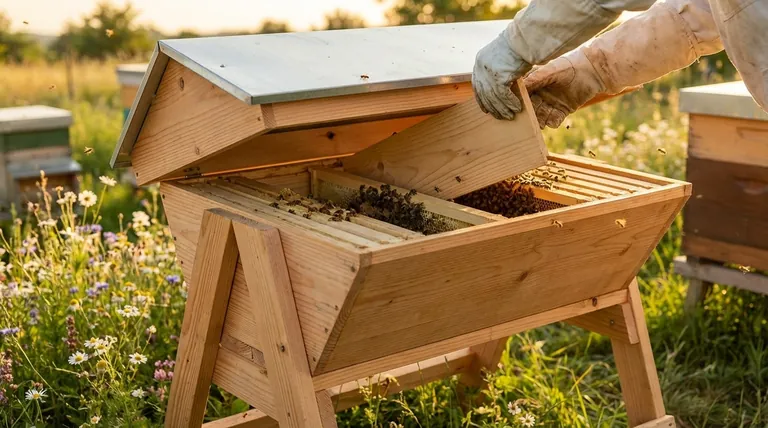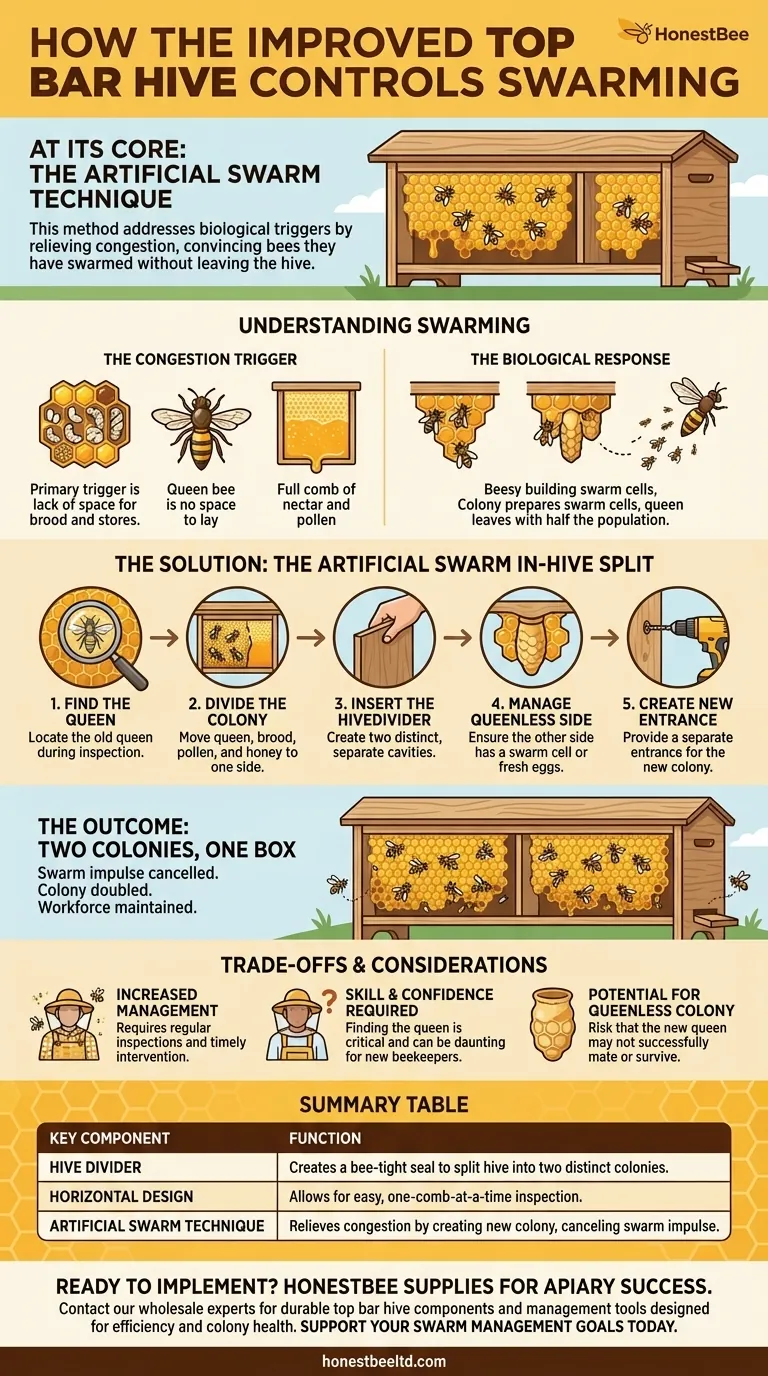At its core, the improved top bar hive design helps with swarm control not through a single physical feature, but by enabling a specific management technique known as an "in-hive split" or "artificial swarm." This method directly addresses the biological triggers for swarming by relieving congestion within the colony, effectively convincing the bees they have already swarmed without them ever leaving the hive. This maintains the colony's workforce and can double your number of active colonies.
Swarming is a natural response to colony congestion. The top bar hive's horizontal design and use of a simple divider board allow a beekeeper to proactively divide the colony, resolving the congestion and canceling the swarm impulse before it leads to the loss of bees.

Understanding the Root Cause of Swarming
Swarming is the honey bee colony's natural method of reproduction. It is not a sign of an unhealthy hive, but rather a robust one that has run out of space.
The Congestion Trigger
The primary trigger for the swarm impulse is congestion. When the brood nest becomes packed with eggs, larvae, and pupae, the queen has no more empty cells in which to lay. Simultaneously, if nectar and pollen stores fill the remaining space, the colony perceives that it has outgrown its home.
The Biological Response
In response, the bees will begin preparations to swarm. They create special "swarm cells" to raise new queens. Just before the new queens emerge, the original queen will leave the hive, taking roughly half of the worker bee population with her to establish a new colony elsewhere.
The Improved Top Bar Hive's Solution: The Artificial Swarm
The "improvement" to the top bar hive is a management system that uses a special divider to create an artificial swarm. This technique preempts the colony's natural impulse by solving the congestion problem for them.
The Key Component: The Hive Divider
The central piece of equipment is a hive divider, which is essentially a solid follower board that fits the hive's dimensions perfectly, creating a bee-tight seal. It allows you to separate the single hive cavity into two distinct, smaller cavities.
How the Technique Works
When you observe signs of swarm preparation, such as backfilled brood comb or the creation of queen cells, you intervene.
- Find the Queen: First, you must locate the old queen. This is made easier by the ability to inspect one comb at a time in a top bar hive.
- Divide the Colony: Move the comb with the queen, along with a few combs of brood, pollen, and honey, to one side of the hive.
- Insert the Divider: Place the solid hive divider next to these combs, securely separating them from the rest of the colony.
- Manage the Queenless Side: The original, now queenless, portion of the colony remains on the other side of the divider. Ensure they have at least one swarm cell (or a comb with fresh eggs) from which they can raise a new queen.
- Create a New Entrance: You then create a separate entrance for one of the two new colonies, typically by drilling a small hole on the opposite end of the hive.
The Outcome: Two Colonies, One Box
The queen's side immediately has ample new space, tricking her colony into believing they have successfully "swarmed" to a new home. The swarm impulse is cancelled. Meanwhile, the queenless side focuses its energy on raising its new queen. You have effectively doubled your colonies and pollination force while preventing the loss of bees.
Understanding the Trade-offs
While highly effective, this management technique is not a passive solution and comes with its own set of considerations.
Increased Management Demands
This is an active, hands-on method of swarm control. It requires the beekeeper to perform regular inspections to spot swarm preparations in a timely manner. Failing to act on time will result in the colony swarming naturally.
Skill and Confidence Required
The most critical step is successfully finding the queen. For a new beekeeper, this can be a daunting and time-consuming task. Performing this technique requires a degree of confidence and skill in handling bees and reading the state of the colony.
Potential for a Queenless Colony
There is always a risk that the queenless half of the split will fail to raise a new, viable queen. If this happens, that colony will eventually perish unless the beekeeper intervenes by either recombining the hive or introducing a new queen.
Making the Right Choice for Your Goal
This technique is a powerful tool, but its suitability depends on your primary objective as a beekeeper.
- If your primary focus is colony growth and pollination: This method is ideal, as it allows you to double your colony numbers and pollination force without losing bees or purchasing new ones.
- If your primary focus is maximum honey production: Creating a split divides your workforce, which may temporarily reduce the single-hive honey surplus you could harvest. Long-term, however, preventing swarms ensures a stronger overall apiary.
- If your primary focus is low-intervention beekeeping: This specific management technique requires active and timely intervention. While a top bar hive can be managed less intensively, this method for swarm control is decidedly hands-on.
By leveraging its unique horizontal design, the top bar hive provides a direct and effective way to manage the fundamental drivers of colony reproduction.
Summary Table:
| Key Component | Function in Swarm Control |
|---|---|
| Hive Divider | Creates a bee-tight seal to split the single hive into two distinct colonies. |
| Horizontal Design | Allows for easy, one-comb-at-a-time inspection to locate the queen and assess colony health. |
| Artificial Swarm Technique | Relieves congestion by creating a new colony within the same hive, canceling the natural swarm impulse. |
Ready to implement this effective swarm control method? HONESTBEE supplies the durable beekeeping supplies and equipment commercial apiaries and distributors need to succeed. Our top bar hive components and management tools are designed for efficiency and colony health. Contact our wholesale experts today to discuss how our products can support your swarm management and apiary growth goals.
Visual Guide

Related Products
- Top Bar Beehive for Beekeeping Wholesales Kenya Top Bar Hive
- Long Langstroth Style Horizontal Top Bar Hive for Wholesale
- HONESTBEE Professional Multi-Functional Hive Tool with Ergonomic Wood Handle
- HONESTBEE Advanced Ergonomic Stainless Steel Hive Tool for Beekeeping
- HONESTBEE Professional Long Handled Hive Tool with Precision Cutting Blade
People Also Ask
- How should a beekeeper prepare a top-bar hive for overwintering? A Guide to Ensure Colony Survival
- What are the benefits of a top bar hive? A Natural, Low-Impact Approach to Beekeeping
- What are the benefits of extra wax production in top bar hives? A Natural Byproduct for Craft & Efficiency
- Why are hive inspections easier with Top Bar Hives? Achieve a Calmer, Safer Approach to Beekeeping
- Which is better Kenya top bar hive or Langstroth? Choose the Right Hive for Your Goals



















